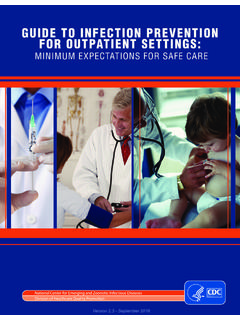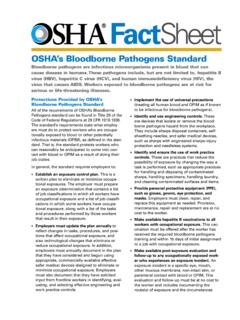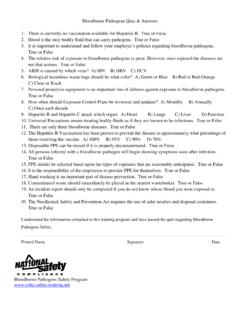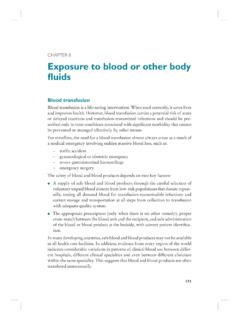Transcription of This PDF has been retired. For updated information, please ...
1 Information from the Centers for Disease Control and Prevention National Center for Infectious Diseases Divison of Healthcare Quality Promotion and Division of Viral Hepatitis For additional brochures contact: The Public Health Foundation 877-252-1200 (toll free) or BloodBlood Exposureto What Healthcare Personnel Need to Know Department of Health & Human ServicesOTHER SOURCES OF INFORMATION HBV and HCV For additional information about hepatitis B and hepatitis C, call the hepatitis information line at 1-888-4-HEPCDC (1-888 443-7232) or visit CDC s hepatitis website at Any reaction or adverse health event after getting hepatitis B vaccine sould be reported to your healthcare provider.
2 The Vaccine Adverse Event Reporting System (1-800-822-7967) receives reports from healthcare providers and others about vaccine side effects. HIV Information specialists who staff the CDC National AIDS Hotline (1-800-342-2437) can answer questions or provide information on HIV infection and AIDS and the resources available in your area. The HIV/AIDS Treatment Information Service (1-800-448-0440) can also be contacted for information on the clinical treatment of HIV/AIDS. For free copies of printed material on HIV infection and AIDS, please call or write the CDC National Prevention Information Network, Box 6003, Rockville, MD 20849-6003, telephone 1-800-458-5231, Internet address Additional information about occupational exposures to bloodborne pathogens is available on CDC s Division of Healthcare Quality Promotion s website at or by calling 1-800-893-0485 and on CDC s National Institute of Occupational Safety and Health s website at or call 1-800-35 NIOSH (1-800-356-4674).
3 HBV-HCV-HIV PEPline (the National Clinicians Postexposure Prophylaxis Hotline) is a 24-hour, 7-day-a-week consultation service for clinicians managing occupational exposures. This service is supported by the Health Resources and Services Administration Ryan White CARE Act and the AIDS Education and Training Centers and CDC. PEPline can be contacted by phone at (888) 448-4911 (toll free) or on the Internet at Cover Photo: Human Red Blood Cells, Copyright Dennis Kunkel, University of Hawaii exposure to Blood What Healthcare Personnel Need to Know OCCUPATIONAL EXPOSURES TO BLOOD Introduction Healthcare personnel are at risk for occupational exposure to bloodborne patho-gens, including hepatitis B virus (HBV), hepatitis C virus (HCV), and human immunodeficiency virus (HIV).
4 Exposures occur through needlesticks or cuts from other sharp instruments contaminated with an infected patient's blood or through contact of the eye, nose, mouth, or skin with a patient's blood. Important factors that influence the overall risk for occupational exposures to bloodborne pathogens include the number of infected individuals in the patient population and the type and number of blood contacts. Most exposures do not result in infection. Following a specific exposure , the risk of infection may vary with factors such as these: The pathogen involved The type of exposure The amount of blood involved in the exposure The amount of virus in the patient's blood at the time of exposure Your employer should have in place a system for reporting exposures in order to quickly evaluate the risk of infection, inform you about treatments available to help prevent infection, monitor you for side effects of treatments, and determine if infection occurs.
5 This may involve testing your blood and that of the source patient and offering appropriate postexposure treatment. How can occupational exposures be prevented? Many needlesticks and other cuts can be prevented by using safer techniques (for example, not recapping needles by hand), disposing of used needles in appropriate sharps disposal containers, and using medical devices with safety features designed to prevent injuries. Using appropriate barriers such as gloves, eye and face protection, or gowns when contact with blood is expected can prevent many exposures to the eyes, nose, mouth, or skin. 1 IF AN exposure OCCURS What should I do if I am exposed to the blood of a patient?
6 1. Immediately following an exposure to blood: Wash needlesticks and cuts with soap and water Flush splashes to the nose, mouth, or skin with water Irrigate eyes with clean water, saline, or sterile irrigants No scientific evidence shows that using antiseptics or squeezing the wound will reduce the risk of transmission of a bloodborne pathogen. Using a caustic agent such as bleach is not recommended. 2. Report the exposure to the department ( , occupational health, infec-tion control) responsible for managing exposures. Prompt reporting is essential because, in some cases, postexposure treatment may be recommended and it should be started as soon as possible. Discuss the possible risks of acquiring HBV, HCV, and HIV and the need for postexposure treatment with the provider managing your exposure .
7 You should have already received hepatitis B vaccine, which is extremely safe and effective in preventing HBV infection. RISK OF INFECTION AFTER exposure What is the risk of infection after an occupational exposure ? HBV Healthcare personnel who have received hepatitis B vaccine and developed immunity to the virus are at virtually no risk for infection. For a susceptible person, the risk from a single needlestick or cut exposure to HBV-infected blood ranges from 6-30% and depends on the hepatitis B e antigen (HBeAg) status of the source individual. Hepatitis B surface antigen (HBsAg)-positive individu-als who are HBeAg positive have more virus in their blood and are more likely to transmit HBV than those who are HBeAg negative.
8 While there is a risk for HBV infection from exposures of mucous membranes or nonintact skin, there is no known risk for HBV infection from exposure to intact skin. 2 HCV The average risk for infection after a needlestick or cut exposure to HCV- infected blood is approximately The risk following a blood exposure to the eye, nose or mouth is unknown, but is believed to be very small; however, HCV infection from blood splash to the eye has been reported. There also has been a report of HCV transmission that may have resulted from exposure to nonintact skin, but no known risk from exposure to intact skin.
9 HIV The average risk of HIV infection after a needlestick or cut exposure to HlV-infected blood is ( , three-tenths of one percent, or about 1 in 300). Stated another way, of needlestick/cut exposures do not lead to infection. The risk after exposure of the eye, nose, or mouth to HIV-infected blood is estimated to be, on average, (1 in 1,000). The risk after exposure of non-intact skin to HlV-infected blood is estimated to be less than A small amount of blood on intact skin probably poses no risk at all. There have been no documented cases of HIV transmission due to an exposure involving a small amount of blood on intact skin (a few drops of blood on skin for a short period of time).
10 How many healthcare personnel have been infected with blood-borne pathogens ? HBV The annual number of occupational infections has decreased 95% since hepatitis B vaccine became available in 1982, from >10,000 in 1983 to <400 in 2001 (CDC, unpublished data). HCV There are no exact estimates on the number of healthcare personnel occupation-ally infected with HCV. However, studies have shown that 1% of hospital healthcare personnel have evidence of HCV infection (about 3% of the population has evidence of infection). The number of these workers who may have been infected through an occupational exposure is unknown. HIV 3 As of December 2001, CDC had received reports of 57 documented cases and 138 possible cases of occupationally acquired HIV infection among healthcare personnel in the United States since reporting began in 1985.

















